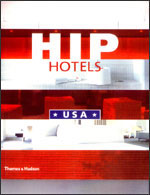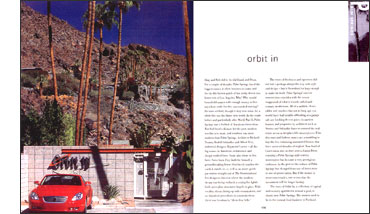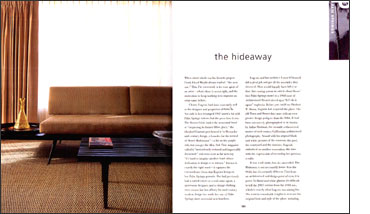 HIP HOTELS, USA
HIP HOTELS, USAby Herbert Ypma
Published by Thames and Hudson
Orbit In has 2 out of 40 listings in this fun book about the nation’s best hip hotels.
Orbit In
(now referred to as Orbit In’s Oasis)
Bing and Bob did it. So did Frank and Dean. For a couple of decades Palm Springs lured the biggest names in show business to come and live in this barren patch of hot rocky desert two hours east of Los Angeles. Why? Why would household names with enough money to live anywhere settle for this sunscorched outcrop? Because unlikely thou it may now seem, for a while this was the brave new world. In the years before and particularly after World War II, Palm Springs was a hotbed of American innovation. War had bred a distaste for the past; modern was the new must, and nowhere was more modern than Palm Springs. Architects Richard Neutra, Rudolf Schindler and Albert Frey, industrial designer Raymond Loewy – all the big names in American architecture and design worked here. Some also chose to live here: Swiss-born Frey built for himself a groundbreaking house that barely touches the earth it stands on, as well as an avant-garde gas station straight out of The Fountainhead. For designers this was where the modern dream was being realized, a setting for lightly built open-plan structures largely in glass. With wealthy clients lining up with commissions, and no historical precedents to constrain them, there was freedom in “them thar hills.”
 The sense of freshness and openness did not last – perhaps always the way with style and design – but it flourished for long enough to make its mark. Palm Springs’ current resurrection coincides with the recent reappraisal of what is loosely called mid-century modernism. All of a sudden, chairs, tables and couches that not so long ago you would have had trouble offloading at a garage sale are fetching decent prices in auction houses, and properties by architects such as Neutra and Schindler have re-entered the real estate arena as irreplaceable masterpieces. Film directors and fashion names are scrambling to buy the few remaining un-restored housed that have survived decades of neglect. Tom Ford of Gucci owns one, as does actress Laura Dern: rescuing a Palm Springs mid-century masterpiece has become a very prestigious endeavor. In the process the culture of Palm Springs has changed from one of innovation to preservation. But if the money is more conservative, one senses that the investment will be longer lasting.
The sense of freshness and openness did not last – perhaps always the way with style and design – but it flourished for long enough to make its mark. Palm Springs’ current resurrection coincides with the recent reappraisal of what is loosely called mid-century modernism. All of a sudden, chairs, tables and couches that not so long ago you would have had trouble offloading at a garage sale are fetching decent prices in auction houses, and properties by architects such as Neutra and Schindler have re-entered the real estate arena as irreplaceable masterpieces. Film directors and fashion names are scrambling to buy the few remaining un-restored housed that have survived decades of neglect. Tom Ford of Gucci owns one, as does actress Laura Dern: rescuing a Palm Springs mid-century masterpiece has become a very prestigious endeavor. In the process the culture of Palm Springs has changed from one of innovation to preservation. But if the money is more conservative, one senses that the investment will be longer lasting.
“…lovingly returned to it’s Rat Pack glamour days”
The story of the Orbit In, a collection of typical mid-century apartments around a pool, is classic new Palm Springs. The owners are in the natural food business in Portland. They came to Palm Springs to escape the rain and gray skies of the Portland winter. On a stroll around one of the most attractive parts of Palm Springs, near the slopes of the San Jacinto Mountains, Christy Eugenis and Stan Amy came across this run-down motel, then called the Village Manor. They hadn’t any real desire to own a hotel, but the creative challenge of restoring Herbert W. Burns’ property to its former style was a temptation too great to resist.
They bought it ……in July of 1999. By that time the only saving grace of the property – which frankly could have won a “most likely scene for a bizarre crime act” competition – was the fact that no one had ever spent any money on it. Benign neglect meant that the original fiber of the building was still there for the saving. The man Eugenis brought in for this task was architect Lance O’Donnell. A native of the area who grew up in a modernist house, O’Donnell came to the project with strong convictions. He mourned the widespread destruction of the modernist legacy of a town that arguably has the greatest collection of mid-century houses in the world. To him Orbit In was an opportunity to salvage “a Hollywood starlet with great bones – she may have been a bit wrinkled but she was still beautiful underneath.” Thus, outside and in, the place was lovingly returned to its Rat Pack glamour days. Furniture and fabrics from the studio of Ray and Charles Eames, framed 1950’s album covers, cocktail bars, atomic-inspired wall clocks, lava lamps, Bertoia chairs, mix and match melmac dinnerware; all was painstakingly assembled in order to create an interior faithful to the buildings origins.
But does all this make the Orbit In a museum reserved for architecture buffs who come to visit all those widely published houses of Palm Springs past masters? Hardly. The message for guests is clear: it’s not just 1950’s content that has been recreated here, but 1950’s attitudes. This is one motel where you can still smoke, drink, sunbake and party just like Sammy, Frank and Dean.
The Hideaway (Hip Hotels, USA)
When asked which was his favorite project, Frank Lloyd Wright always replied: “the next one.” This, I’m convinced, is the true spirit of an artist – what’s done is never right, and the motivation to keep working is to improve on the came before.
Christy Eugenis had done extremely well as the designer and proprietor of Orbit In (now known as Orbit In’s Oasis). Not only is her revamped 2957 motel a hit with Palm Springs visitors, but the press love it too. The Boston Globe hailed the renovated hotel as “surpassing its former fifties glory”; the Hartford Courant proclaimed it “a Mecca for mid-century design, a Lourdes for the revival of Desert Modernism” – a bit on the purple side, but you get the idea. The HideawayAnd Time Magazine called it “meticulously restored and impeccably  decorated,” and even went as far as to say “it’s hard to imagine another hotel whose dedication to design is so intense.” Intense is exactly the right word – it captures the extraordinary focus that Eugenis brings to her Palm Springs pursuits. She had previously have a varied career as a real estate agent, a sportswear designer, and a vintage clothing store owner, but her affinity for mid-century modern design has made her one of Palm Springs most successful new hoteliers.
decorated,” and even went as far as to say “it’s hard to imagine another hotel whose dedication to design is so intense.” Intense is exactly the right word – it captures the extraordinary focus that Eugenis brings to her Palm Springs pursuits. She had previously have a varied career as a real estate agent, a sportswear designer, and a vintage clothing store owner, but her affinity for mid-century modern design has made her one of Palm Springs most successful new hoteliers.
Eugenis and her architect Lance O’Donnell did a great job and got all the accolades they deserved. Most would happily have left it at that. But coming across and article about Burns’ first Palm Springs motel in a 1948 issue of Architectural Record stirred up a “let’s do it again” euphoria. Before you could say Herbert W. Burns, Eugenis had acquired the place. The old Town and Desert Inn came with an even greater design pedigree than the Village Manor. It had been extensively photographed in its heyday by Julius Shulman, the recently rediscovered master of mid-century Californian architectural photography. Armed with his original black and white pictures of the exteriors, the pool, the courtyard and the interiors, Eugenis embarked on another renovation, this time with the express aim of exceeding her previous results.
“meticulously restored and impeccably decorated”
It was a tall order, but she succeeded. The Hideaway is not necessarily better that the Orbit In’s Oasis, but it’s certainly different. First from an architectural and design point of view, it is purer. In black-and-white photos, it’s difficult to tell the 2003 version from the 1948 one, which is exactly what Eugenis was aiming for. She went to remarkable lengths to recreate the original look of the place, including sourcing a collection of Aimes Aire pool furniture. Interior furniture by modern masters Eames, Bertoia, Risom, Paulin and Breuer was mainly collected in Palm Springs by Eugenis herself. Then in a nice twist, she purchased Shulmans original pictures and used them to decorate the interiors.
The seagrass on the floor is the same as at the Oasis, but in terms of details that’s pretty much where the parallels with its sister motel end. The original Orbit In (now the Oasis) was intended to be fun, sociable and colorful, with a touch of Rat Pack-esque debauchery, but the Hideaway is for purists – connoisseurs who like their modernism authentic and peaceful. Thus while the Oasis has a certain buzz, theirs a confident calm at the Hideaway. In keeping with its low-key intent, there’s no sign outside, not even a little one. It looks like a perfectly preserved modernist apartment complex, or perhaps a bungalow, but certainly not a hotel. The Hideaway has no lobby, no reception desk, in fact no public spaces at all unless you count the living room at the other end of the complex, which looks uncannily as it does in Shulman’s 1940’s photographs.
Of the two Eugenis projects, the first is undoubtedly fore fun, but even so I prefer the Hideaway. Its atmosphere gives a rare insight into the spirit of refinement and ease that the architecture and design of this period could achieve. Staying in this neutrally toned, perfectly groomed piece of mid-century design you really start to understand what all the fuss was about. This place has real artistic integrity- a fact not lost on the New York-based art photographer I ran into while I was there. She and her model were traveling the area seeking to capture mid-century moments. There could be no more perfect setting for their enterprise. While I was busy photographing the interior, she had her model pulling sown his swimsuit by the edge of the pool. On Polaroid it definitely looked like a martini moment – or rather, a post-martini moment. Art imitating life: surely a telling endorsement.
